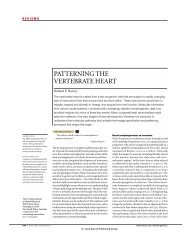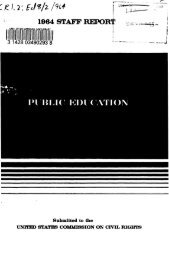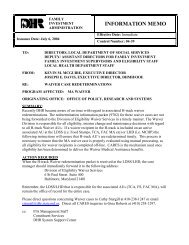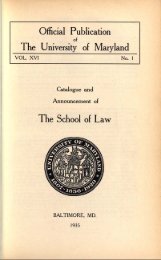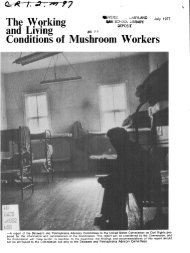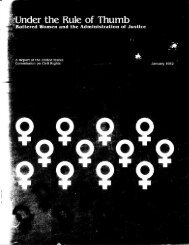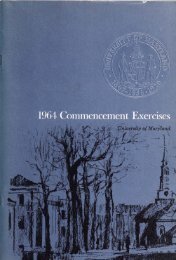1961 US Commission on Civil Rights Report Book 2 - University of ...
1961 US Commission on Civil Rights Report Book 2 - University of ...
1961 US Commission on Civil Rights Report Book 2 - University of ...
You also want an ePaper? Increase the reach of your titles
YUMPU automatically turns print PDFs into web optimized ePapers that Google loves.
January January<br />
1958 <str<strong>on</strong>g>1961</str<strong>on</strong>g><br />
(percent) (percent)<br />
Track I l 7- o 20. 7<br />
Track II 45-9 5 2 - 4<br />
Track III 47.1 21.3<br />
Terminal educati<strong>on</strong> 2 5.6<br />
1 St. Louis sec<strong>on</strong>dary schools operate 3 basic curriculum tracks: track I for aboveaverage<br />
achieversj track II for average achievers, and track III for below-average<br />
achievers.<br />
2 This classificati<strong>on</strong> includes graduating students, who because <strong>of</strong> intellectual limitati<strong>on</strong>s<br />
and age do not appear to be able to benefit from the regular track III program.<br />
The key to the entire program seems to have been inspired leadership.<br />
Dr. Shepard encouraged principals to initiate programs for raising pupil<br />
performance and changing teachers' attitudes toward the possibility <strong>of</strong><br />
higher pupil achievement. 42 Teachers were adm<strong>on</strong>ished to stop "teaching<br />
by supposed IQ"; parents were told <strong>of</strong> the poor performance <strong>of</strong> their<br />
children, urged to cooperate with the school <strong>on</strong> homework assignments,<br />
and instructed how to do so. 43 Children were spurred by assembly<br />
programs, field trips, peptalks, h<strong>on</strong>or assemblies, and posters. 44<br />
Dr. Shepard explained to the <str<strong>on</strong>g>Commissi<strong>on</strong></str<strong>on</strong>g> his c<strong>on</strong>cept <strong>of</strong> the differentiated<br />
treatment <strong>of</strong> pupils he calls teaching by IQ, with the following<br />
story: 48<br />
. . . here was a teacher who had copied the IQ numbers down the<br />
line from a list in the principal's <strong>of</strong>fice . . . throughout the semester<br />
if the teacher called <strong>on</strong> Mary, let us say, with an IQ <strong>of</strong> 119, she<br />
followed somewhat this pattern: If Mary didn't resp<strong>on</strong>d quickly,<br />
"Well, now, come <strong>on</strong>, Mary. You know you can do this. You<br />
know how we did this yesterday," or bring up an analogous situati<strong>on</strong>.<br />
She encouraged, she stimulated, until Mary came up with<br />
the proper answer, or what the teacher at least c<strong>on</strong>sidered an adequate<br />
<strong>on</strong>e. However, when she called <strong>on</strong> poor John with his 74<br />
IQ, if he mumbled something fairly audible, why, this was w<strong>on</strong>derful<br />
; pat him <strong>on</strong> the back and, "Be sure and be here tomorrow. You<br />
can wash the windows and help move the piano and water the<br />
flowers, and the erasers must be washed," and so forth. This is<br />
the kind <strong>of</strong> encouragement that he got with a 74. This is teaching<br />
by IQ. She was a little horrified at the end <strong>of</strong> the semester when<br />
she turned in her grades. She looked under the glass and saw that<br />
the columns she had copied for IQ's were locker numbers. Now,<br />
this is about what goes <strong>on</strong>.<br />
The table below, showing the improved performance <strong>of</strong> the children in<br />
the Banneker schools (which by January <str<strong>on</strong>g>1961</str<strong>on</strong>g> had equaled nati<strong>on</strong>al<br />
norms), suggests that elaborate and costly remedial programs may not<br />
126




